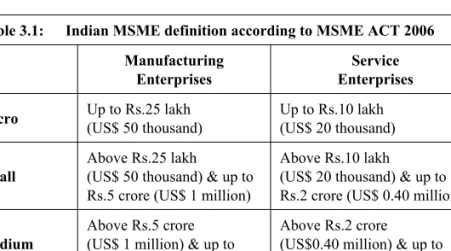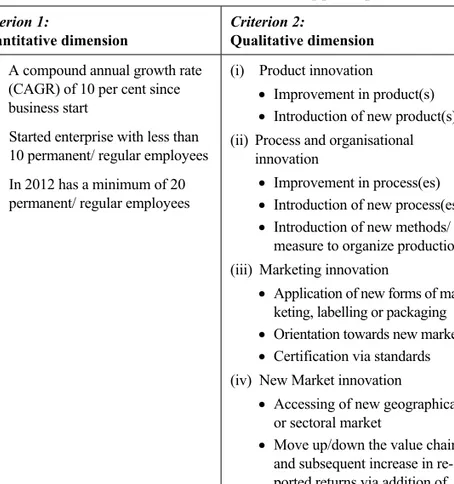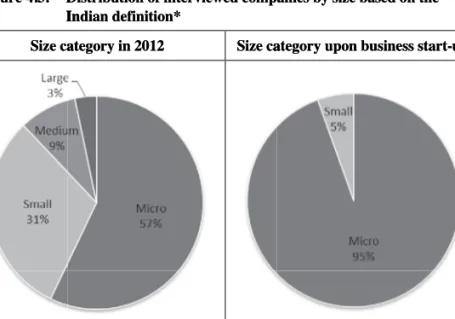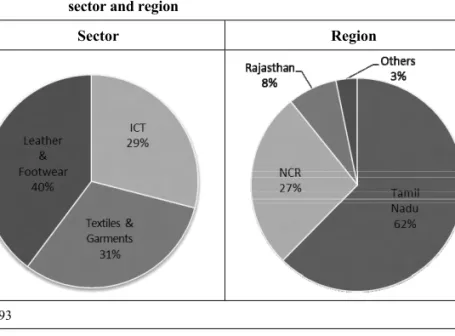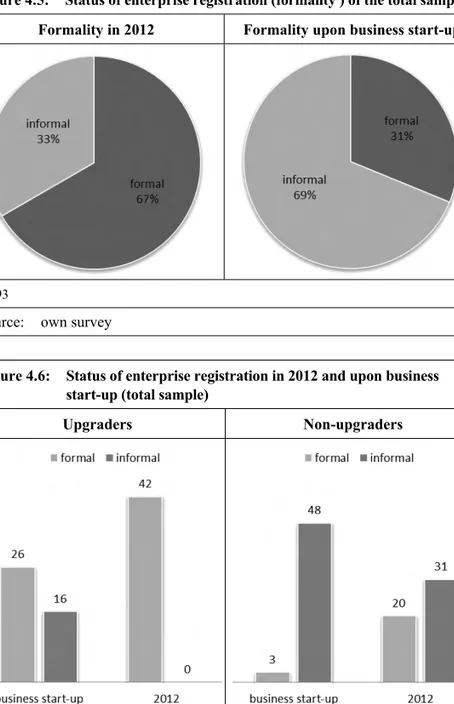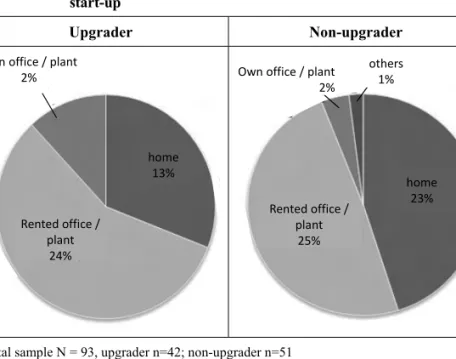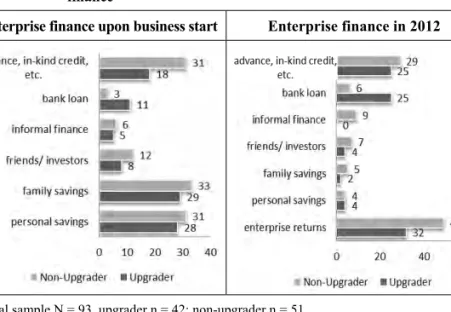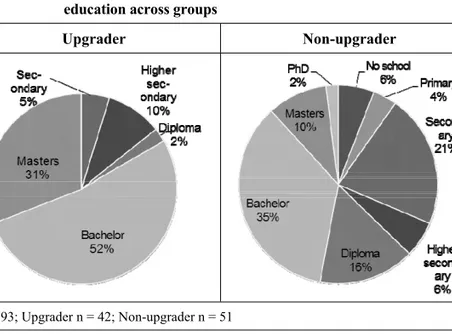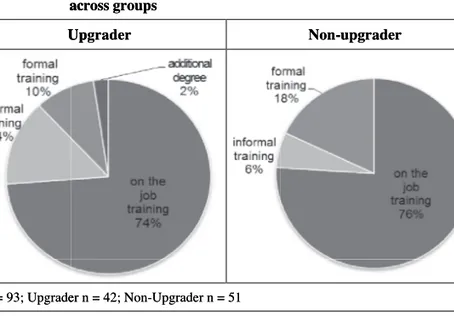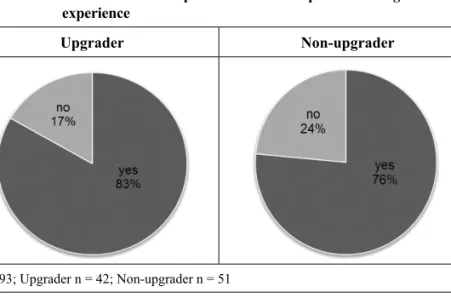Caroline Reeg
Micro, small and medium enterprise upgrading
in India
Caroline Reeg,is a Researcher at the German Development Institute / Deutsches Institut für Entwicklungspolitik (DIE), in the Competitiveness and Social Develop- ment Department, since 2011. She finished a degree in Political Science (MSc) from University of Potsdam, and Development Studies (MSc) from London School of Economics and Political Science (LSE). Before 2011, she worked at the Deutsche Gesellschaft für Internationale Zusammenarbeit (GIZ) in Berlin and Frankfurt. Her main areas of research and expertise are basic issues of development policy, eco- nomic development, Micro, Small and Medium enterprises (MSMES) and private sector development in India.
E-Mail: caroline.reeg@die-gdi.de
The German Development Institute / Deutsches Institut für Entwicklungs- politik (DIE)is a multidisciplinary research, consultancy and training institute for Germany’s bilateral and for multilateral development cooperation. On the basis of independent research, it acts as consultant to public institutions in Germany and abroad on current issues of cooperation between developed and developing countries. Through its 9-months training course, the German Development Institute prepares German and European university graduates for a career in the field of development policy.
Studies
Deutsches Institut für Entwicklungspolitik
78
Micro, small and medium enterprise upgrading in India
Learning from success cases
Caroline Reeg
Bonn 2013
Studies / Deutsches Institut für Entwicklungspolitik ISSN 1860-0468
Die deutsche Nationalbibliothek verzeichnet diese Publikation in der Deutschen Nationalbibliografie; detaillierte bibliografische Daten sind im Internet über http://dnb.d-nb.de abrufbar.
The Deutsche Nationalbibliothek lists this publication in the Deutsche Nationalbibliografie; detailed bibliographic data is available in the Internet at http://dnb.d-nb.de
ISBN 978-3-88985-585-5
© Deutsches Institut für Entwicklungspolitik gGmbH Tulpenfeld 6, 53113 Bonn
+49 (0)228 94927-0 +49 (0)228 94927-130 E-Mail: die@die-gdi.de http://www.die-gdi.de
! "
Acknowledgements
This study is part of a three country research project1in Egypt, India and the Philippines funded by the DIE, the Bundesministerium für wirtschaftliche Zusammenarbeit und Entwicklung (BMZ) and a German public-sector financial institution, the KfW. The Indian case study is a cooperative effort between the DIE, KfW and the Small Industries Bank of India (SIDBI).
I would like to take this opportunity to express my gratitude for the coop- eration of all my interlocutors from different fields for the warm, kind and pleasant atmosphere in which I was received by them and virtually every- where in Germany and India.
In particular, I thank the following persons for their invaluable support:
Tilman Altenburg (DIE), Aimée-Hampel-Milagrosa, Markus Loewe (DIE), Joachim Heidebrecht (KfW), Julia Kubny (KfW), Maike Lerch (KfW), Rukmini Parthasarathy (KfW), Ajay Kumar Kapur (SIDBI), Dr. R.K. Singh (SIDBI), M. Viswanathan (UNIDO Chennai), Tamal Sarkar and Mukesh Gulati (Foundation for MSME Clusters), P.M. Mathew (Institute for Small Enterprise Development), Gurpal Singh (CII), Hemant Seth (FICCI), Hubert Schmitz (IDS), Peter Knorringa (ISS).
My very special thanks go to my interpreters Vibhuti Bhandari, Vandana Malya and Sheela Viswanathan.
Thank you very much for all your support!
Bonn, June 2013 Caroline Reeg
1 A synthesis paper on the joint research findings will be published in October 2013. The publications for the Egypt and Philippines case studies are available on the DIE’s webpage: www.die-gdi.de.
Contents
Acknowledgements Abbreviations
Executive summary 1
1 Introduction 9
2 MSME upgrading – a conceptual framework 15
2.1 MSME upgrading definition 16
2.2 Determinants of MSME upgrading 19
2.2.1 Internal factors 20
2.2.2 External factors 28
2.3 Trajectories of upgrading 39
3 Micro, small and medium enterprises (MSMEs) in India 43
4 Research methodology 44
4.1 Research design 46
4.2 Definition of MSMEs, sample selection and data analysis 50
4.3 Total sample composition 55
5 MSME upgrading in India – findings 61
5.1 Upgraders and non-upgraders 62
5.1.1 Enterprises 62
5.1.2 Entrepreneurs 69
5.1.3 Social and business networks 74
5.1.4 Business environment 84
5.2 The Information and Communication Technology (ICT)
sector 86
5.2.1 Sector overview 86
5.2.2 ICT sample composition 89
5.2.3 ICT upgraders vs. non-upgraders 95
5.2.4 ICT combinations of success 110
5.3 The Textiles and Garments (T&G) sector 118
5.3.1 Sector overview 118
5.3.2 T&G sample composition 122
5.3.3 T&G upgraders vs. non-upgraders 127
5.3.4 T&G combinations of success 143
5.4 The Leather and Footwear (L&F) sector 153
5.4.1 Sector overview 153
5.4.2 L&F sample composition 156
5.4.3 L&F upgraders vs. non-upgraders 162
5.4.4 L&F combinations of success 178
5.5 Main messages 188
6 Policy implications 203
Bibliography 223
Annexes 243 Table A1: Cross-sectoral differences between types of innovation 245 Table A2: Cross-sectoral differences between enterprises 246 Table A3: Cross-sectoral differences between entrepreneurs 248 Table A4: Cross-sectoral comparison between family and social
networks 249
Table A5: Cross-sectoral comparison of identity and community
networks 251
Table A6: Cross-sectoral comparison of forward and backward
linkages 252
Table A7: Cross-sectoral comparison of competition and local
institutional support 254
Table A8: Cross-sectoral comparison in the perception of the
business environment 255
Table A9: Cross-sectoral ranking of constraints and success factors 257 Table A10: Types of innovation among ICT enterprises 258
Table A11: ICT enterprise characteristics 259
Table A12: ICT entrepreneur characteristics 261
Table A13: Family and social networks among ICT enterprises 263 Table A14: Community/ Caste networks among ICT entrepreneurs 265 Table A15: Forward and backward linkages among ICT enterprises 266 Table A16: Competition and local institutional support among
ICT enterprises 268
Table A17: The perception of the business environment among
ICT entrepreneurs 269
Table A18: Ranking of constraints and success factors among ICT enterprises Table A19: Types of innovation among
T&G entrepreneurs 271
Table A19: Types of innovation among T&G entrepreneurs 272 Table A20: T&G enterprise characteristics 273 Table A21: T&G entrepreneur characteristics 275 Table A22: Family & social networks characteristics among T&G
entrepreneurs 277
Table A23: Community characteristics among T&G entrepreneurs 279 Table A24: Forward and backward linkages among T&G enterprises 280 Table A25: Competition and local institutional support among
T&G entrepreneurs 282
Table A26: Perception of the business environment among T&G
entrepreneurs 283
Table A27: Ranking of success factors and constraints among
T&G entrepreneurs 285
Table A28: Types of innovation among L&F enterprises 286 Table A29: L&F enterprise characteristics 287 Table A30: L&F entrepreneur characteristics 289 Table A31: Family & social network characteristics among L&F
entrepreneurs 291
Table A32: Community characteristics among L&F entrepreneurs 293 Table A33: Forward and backward linkages among L&F enterprises 294 Table A34: Competition and local institutional support among
L&F enterprises 296
Table A35: Perception of the business environment among L&F
enterprises 297
Table A36: Ranking of success factors and constraints among
L&F enterprises 299
Figures in Text
Figure 2.1: Definition of enterprise upgrading 18
Figure 2.2: Conceptual onion layers 20
Figure 4.1: Survey areas for Indian case study 54 Figure 4.2: Distribution of interviewed companies by MSME
employment definition 57
Figure 4.3: Distribution of interviewed companies by size based
on the Indian definition 58
Figure 4.4: Distribution of interviewed companies by economic
sector and region 59
Figure 4.5: Status of enterprise registration (formality) of the
total sample 60
Figure 4.6: Status of enterprise registration in 2012 and upon
business start-up (total sample) 60
Figure 5.1: Comparison of companies by operational location
at business-start-up 63
Figure 5.2: Market orientation of enterprises at business-start-up 64 Figure 5.3: Market orientation of enterprises in 2012 65 Figure 5.4: Comparison of frequencies of mentioned sources of
enterprise finance 67
Figure 5.5: Comparison of types of entrepreneurs across samples 68 Figure 5.6: Cross-sectoral comparison of the entrepreneurs’
formal education across groups 70
Figure 5.7: Cross-sectoral comparison of the entrepreneurs’
training across groups 71
Figure 5.8: Cross-sectoral comparison of the entrepreneurs’
wage work experience 72
Figure 5.9: Cross-sectoral comparison of entrepreneurs’
information sources 73
Figure 5.10: Cross-sectoral comparison of the entrepreneurs’
father’s education 75
Figure 5.11: The IT offshore service value chain 88 Figure 5.12: Distribution of interviewed ICT companies by MSME
employment definition 90
Figure 5.13: Distribution of interviewed ICT companies by size
based on the Indian definition 91
Figure 5.14: Employment growth in the ICT upgrader sample from
1991–2012 93
Figure 5.15: Employment growth in the ICT non-upgrader sample
from 1991–2012 94
Figure 5.16: Formality and informality among ICT enterprises at
business start 95
Figure 5.17: Market orientation of ICT enterprises at business-
start-up 96
Figure 5.18: Market orientation of ICT enterprises in 2012 97 Figure 5.19: Comparison of types of entrepreneurs across samples 99 Figure 5.20: Inter-linkages of success factors and constraints in the
ICT sector 118
Figure 5.21: The Textile & Garments value chain 120 Figure 5.22: Distribution of interviewed T&G companies by
MSME employment definition 123
Figure 5.23: Distribution of interviewed T&G companies by size
based on the Indian MSME definition 123
Figure 5.24: Employment growth in the T&G upgrader sample
from 1991–2012 125
Figure 5.25: Employment growth in the T&G non-upgrader sample
from 1991–2012 126
Figure 5.26: Formality and informality among ICT enterprises at
business start 127
Figure 5.27: Market orientation of ICT enterprises at business-
start-up 129
Figure 5.28: Market orientation of ICT enterprises in 2012 129 Figure 5.29: Comparison of types of entrepreneurs across samples 131 Figure 5.30: Comparison of education of T&G entrepreneurs 133 Figure 5.31: Inter-linkages of success factors and constraints in
the T&G sector 153
Figure 5.32: The Leather & Footwear value chain 155 Figure 5.33: Distribution of interviewed L&F companies by
MSME employment definition 157
Figure 5.34 Distribution of interviewed L&F companies by size based on the Indian MSME definition 158 Figure 5.35: Employment growth in the L&F upgrader sample
from 1991–2012 160
Figure 5.36: Employment growth in the L&F non-upgrader sample
from 1991–2012 161
Figure 5.37: Formality and informality among L&F enterprises at
business start 162
Figure 5.38: Market orientation of L&F enterprises at business-
start-up 163
Figure 5.39: Market orientation of L&F enterprises in 2012 164 Figure 5.40: Comparison of types of entrepreneurs across the
L&F sample 165
Figure 5.41: Inter-linkages of success factors and constraints in
the L&F sector 188
Figure 5.42: Key constraints to upgrading based on onion layers
(see Figure 2.2) 191
Figure 5.43: Key success factors for upgrading based on onion
layers (see Figure 2.2) 198
Figure 6.1: Targeted levels of policy intervention for MSME
upgrading 219
Tables in Text
Table 3.1: Indian MSME definition according to MSME Act 2006 43 Table 4.1: Time-line of the research mission during 2012–2013 50 Table 4.2: Set of indicators for the verification of upgrading 52 Table 5.1: Ranking of onion layers among ICT upgraders 106 Table 5.2: Ranking of onion layers among ICT non-upgraders 108 Table 5.3: Ranking of onion layers among T&G upgraders 140 Table 5.4: Ranking of onion layers among T&G non-upgraders 142 Table 5.5: Ranking of onion layers among L&F upgraders 175 Table 5.6: Ranking of onion layers among L&F non-upgraders 177 Table 6.1: Overview of policy recommendations 220
Abbreviations
ADB Asian Development Bank
BDS Business development services BPO Business Process Outsourcing CAGR Compound annual growth rate
DIE Deutsches Institut für Entwicklungspolitik GDP Gross Domestic Product
GIZ Gesellschaft für Internationale Zusammenarbeit GVC Global value chains
ICT Information and Communication Technology ITO Information Technology Outsourcing KfW Kreditanstalt für Wiederaufbau KPO Knowledge Process Outsourcing L&F Leather & Footwear
MFA Multi-Fibre Agreement
MGNREGA Mahatma Gandhi National Rural Employment Guarantee Act
MSE Micro and small enterprise
MSME Micro, small and medium enterprise
NASSCOM National Association of Software and Services Companies NCR National Capital Region
R&D Research & Development SaaS Software as a Service
SEZ Special Economic Zone
SIDBI Small Industries Development Bank of India SME Small and medium enterprise
SSI Small scale industry T&G Textiles & Garments
TUFS Technology Upgradation Fund Scheme
UNIDO United Nations Industrial Development Organization WTO World Trade Organization
Executive summary
In developing countries micro and small enterprises (MSEs) constitute a large part of the industrial fabric, which is why policymakers and scholars alike look at small-scale entrepreneurs as important develop- ment agents in society. By offering possibilities to gain income, train- ing and work experience, micro and small enterprises are said to pro- vide livelihoods to millions of people worldwide (Altenburg / Eckhardt 2006). Moreover, donors and policymakers stylize small enterprises as drivers of private sector development.
However, the view of micro and small enterprises as being a seedbed for future enterprise growth and upgrading is open to doubt. Across developed and developing economies empirical observations suggest that most micro and small enterprises are stagnating (Mead 1994;
Mead / Liedholm 1998; Cotter 1996; Fajnzylber / Maloney / Montes- Rojas 2006; Fajnzylber / Maloney / Montes-Rojas 2009). Only a minor- ity of these firms manage to upgrade their businesses to the next level of productivity, assets and employment (Berner / Gomez / Knorringa 2008). Typically, few small enterprises pass the threshold of 20 employ- ees. As a result, there is a “missing middle” between the poles of large and micro and small enterprises, respectively.
Generally, the term upgrading has been used to indicate the need for a qualitative improvement in economic production and performance. The need to upgrade productive capabilities has been applied to different units of analysis, e.g. enterprise clusters, economic sectors, industries and latecomer economies in general. However, this paper will exclu- sively follow a disaggregated view on upgrading by single enterprises.
Thus, the focus of attention is on the firm and its individual efforts to increase its return on investment and value added in production.
Accordingly, this study understands enterprise upgrading as growth of MSMEs through firm-level innovation.
This study contributes to filling the gap in the empirical literature on MSE upgrading. The Indian MSME upgrading case study is part of a three-country research project aiming at studying MSME enterprise upgrading dynamics in Egypt, Philippines and India conducted by the
German Development Institute (DIE). The aim of this research is to explain which factors affect enterprise upgrading and how those enter- prises that graduated into higher size segments have managed to do so.
Accordingly, this study is guided by the following research questions:
1. Why do some micro and small enterprises succeed in making progress while others do not?
2. What are the critical success factors that facilitate the increase in employment, assets and production capabilities?
3. How does the process of micro and small enterprise upgrading unfold?
In order to answer these questions this study adopted a qualitative research design, in which the main objective is to identify a critical mass of successful “upgraders” and to systematically document and analyse their experiences in-depth compared to enterprises which have not upgraded (“non-upgraders”). Empirical research in India covering the National Capital Region (NCR), Jaipur (Rajasthan) and surrounding as well as northern parts of Tamil Nadu, including Chennai, was conducted.
This study covers the Information and Communication Technology (ICT), the Textiles and Garments (T&G) and the Leather and Footwear (L&F) sectors. The core element of our research mission was a survey with 93 entrepreneurs that consisted of 42 upgraders and 51 non- upgraders. The author is aware of the limitation of this research design as it provides only a very small sample of “upgraders” and the data allows only few snapshots on some causal relations in the process of MSE upgrading. However, the quality and depth of the data as well as the breath may be valid for the regions and sectors covered by the study.
The question as of why some MSMEs in developing countries innovate and grow and others do not has been subject of interdisciplinary discus- sions. Generally, factors as to why enterprises differ in their perform- ance to innovate and grow can be divided between those that relate to the internal quality of the firm and those external to the firm. Accord- ing to this twofold categorization further sub-levels of upgrading deter- minants have been identified in our conceptual framework: entrepre- neur characteristics (1), enterprise characteristics (2), social (3) and business networks (4) and the business environment (5).
All told, while in a given context some factors will be more important than others, there is no such a thing as a ‘recipe’ for enterprise success or a ‘theory’ of firm development. This is not a new insight. Empirical research in many countries has shown that monocausal approaches fall short in explaining the very idiosyncratic and cumulative process of enterprise upgrading. The heterogeneity among micro and small enter- prises across and within countries in terms of business environments, interconnectivity with networks, abilities and strategies implies that along the way different factors will play a role at different times.
While understanding the development of micro and small firms the main objective of this study is to learn from success cases of firms:
“upgraders”. In 2000 Morris et al. (2000, 50 f.) suggested different styl- ized scenarios of how MSMEs in India could transform and upgrade enterprises with higher levels of productivity into successful MSMEs.
They suggest three successful trajectories for MSMEs to upgrade: (i) transforming traditional firms, (ii) growing trader manufacturers and (iii) firms at the beginning of the “high road”: Depending on the devel- opmental path, enterprises will face certain challenges, making partic- ular factors combined instrumental to succeed in upgrading. Thus, depending on a developmental trajectory, success factors and their combinations supporting upgrading will vary.
In order to identify different upgrading trajectories and the positive fac- tors driving this process, the gathered data has been analysed in two ways. First, characteristics of upgraders and non-upgraders were sys- tematically compared in order to identify differences between the two samples across sectors. Second, in-depth analysis of upgraders and non-upgraders at the sector level provides deeper insights into group differences as well as differing combinations of success in upgrading.
Across sectors, the study advances with ten major messages:
1. Micro and small enterprise (MSE) upgrading takes place!
Upgraders are indeed an exception, however, there are a consider- able number of entrepreneurs who manage to innovate and grow their businesses incrementally. Depending on the sector, this process might take more than a few years, in fact, upgrading of
traditional manufacturing businesses was being initiated and car- ried forward by one or two generations, involving processes of market and product reorientation and fundamental technological transformation. Also, as enterprise upgrading is an incremental process many achievements by MSEs in innovating in products and services are constantly threatened by market shocks and there- fore growth in employment is difficult to sustain steadily. Accord- ingly, there exists variation in upgrading trajectories.
2. Sectors and regions matter: When explaining micro and small enterprise upgrading the country, sectoral as well as regional con- text has to be taken into account. India is a complex political union of 26 states which all strongly vary in their socio-cultural and eco- nomic conditions. Enterprises are embedded in different regional settings providing them with different opportunities that define the boundaries of what is possible for an individual company. Further, depending on booms and busts in certain sectors there exist more or less viable market opportunities for an MSE to start a company or a new product line. Thus policy recommendations have to be tailored not only specific to a certain country and region, but should further build on trends in certain product and service cate- gories which requires sector know-how. The latter differentiation is of vital importance as the nature of the enterprises’ economic activities strongly determines available coping strategies and upgrading trajectories.
3. Micro and small enterprise (MSE) upgrading requires a combina- tion of success factors:This explorative research aimed to show that while public debates very often highlight simplified mono- causal explanations in explaining enterprise development, such as access to finance, the embeddedness in a cluster or its informal sta- tus, enterprise upgrading is a phenomenon that depends on certain combinationsof success factors. Enterprises find themselves con- fronted with several challenges and upgrading constraints for which they need a variety of coping strategies and success factors.
However, how these particular combinations of success factors materialize strongly relates to the country and sector context, which is why it is dangerous to formulate a generalized “winning”
strategy for MSEs. Rather, in its sector-specific Subchapters on the ICT, T&G and L&F sectors this study has shown that the factor ingredients of these combinations can vary greatly. A major take- away though is that enterprise success strongly relies on the inter- action of a well-informed, educated and socially-embedded entre- preneur using his personal networks to compensate for various deficits in the business environment, such as lack of finance. This implies that while entrepreneurs can compensate to a large degree for deficits in the business environment MSE success rates will be higher where entrepreneurial drive and the provision of soft and hard infrastructure go hand in hand.
4. Entry barriers for woman entrepreneurs exist:While there have been several policy efforts to support and increase entrepreneur- ship among women in India, e.g. microfinance schemes with relaxed interest rates, there seem to still exist huge entry barriers for women. The sample consists of 93 interviews, of which only 4 were with women entrepreneurs. Accordingly, no inferences of the relative performance of women compared to men can be made;
however, this sampling outcome implies that there are strong entry barriers for women in becoming an entrepreneur. Those women who were taking up entrepreneurship were all owning a business in the textiles and garments sector; they were highly educated and reported to having a very supportive and understanding family and social network assisting them in their business. The reasons for this outcome are manifold. Interviews with woman entrepreneurs indicated that family obligations and social norms influence the individual preferences and decisions of potentially equipped busi- ness women. While there are exceptions, it appears that entry bar- riers are historically and culturally rooted and therefore will change only slowly.
5. The entrepreneur’s capabilities and social exposure matter a lot:
Most of the identified success factors across all three sectors are strongly associated with the entrepreneur’s human capital as well as his embeddedness in particular quality networks. While recent literature has highlighted external variables such as registration procedures, access to finance and informality, the qualities of the
entrepreneur as well as those of his social milieu seem to be under- estimated. Yet, the case of upgraders shows that these “soft” vari- ables are much more important than recent literature has stated.
Most success factors in the end depend on entrepreneur and net- work characteristics such as quality of education, quality work experience, motivation, family background and quality networks.
The entrepreneurs’ coping strategies to overcome challenges such as access to finance, access to markets and access to workers largely relied on their own capabilities to makes use of their own or their social and business networks knowledge and capital resources. Accordingly, this study can support notions of a strong identity and networkled economy in the studied sub-sectors (Meagher 2010).
6. Informality is not a constraint to upgrading in itself!Formalization is the outcome rather than the driver of upgrading. Many entre- preneurs upgraded their business out of the informal sector and formalized after they had sustained growth for a longer period of time. For many enterprises, it was a deliberate decision to remain informal due the perceived advantages and disadvantages of reg- istration. Once enterprise had stable orders and projects, the com- panies gradually reconsidered the benefits of registration and gradually made the efforts to register under different corporate statutory laws and acts.
7. Regulatory framework and state bureaucracy are no constraints to upgrading in themselves! Complicated procedures and unclear regulatory specifications as suggested by the Doing Business Reports raise search and transactions costs (money and time) for upgraders (World Bank 2011). Yet, most upgraders managed to overcome these challenges. Rather than the sheer number of pro- cedures and the compliance with the regulatory framework the major problem of entrepreneurs lies in predicting whether laws and rules will be applied adequately. In most cases entrepreneurs had to pay-off officials no matterwhether they were complying with procedures or not. Thus, deficits in the rule of law frequently result in unethical practices and corruption for which entrepre- neurs have to bear the costs.
8. For MSEs initially access to markets is a more severe challenge to upgrading than lack of finance. Lack of finance has been dis- cussed as a major growth constraint for MSMEs. Having the nec- essary capital to start and run a company for the first initial months constitutes a bottleneck for many entrepreneurs and indeed upgraders had considerably better access to various private sources of finance as well as some bank loans to overcome initial start-up costs and times of capital squeezes. However, upgraders were shown to have strong market linkages and access to support- ive clients and buyers beforestarting their business, indicating that access to markets might be more instrumental to initial enterprise growth than access to external finance. A major strategy of upgraders was to grow slowly and compensate for the lack of external finance by using in-kind credit and other forms of strate- gic partnerships with their initial market linkages. Hence, addi- tional to private savings upgraders used clients as a source of finance, which not only provided the necessary capital to start the business, but more importantly lowered business risks by ensuring effective and secure demand for their products and services. Thus, initially access to markets seems to be more important to MSEs than access to large amounts of capital and bank loans, not only because clients constituted an alternative source of finance, but more importantly because this arrangement ensured a guaranteed sales market as a basis for further growth.
9. Lack of access to bank finance becomes a more severe growth bot- tleneck at later stages of small enterprise development.Evidence suggests that upgraders experienced lack of bank finance to be a more pronounced growth constraint at later stages of the com- pany’s development rather than in the beginning. Only after the establishment of reliable market linkages did entrepreneurs require larger amounts of capital for business expansion, research and development as well as to level out short-term capital squeezes. However, only very few upgraders were able to access a corporate loan. Rather entrepreneurs used private loans to fund their business as these were easier to obtain. In particular, entre- preneurs reported an array of deficits in the provision of adequate financing when aiming for corporate loans. The most salient prob-
lem is the perceived benefit and cost ratio. For most entrepreneurs handling the necessary procedures and documentation as well as the disclosure of sensitive financial information was not worth- while in comparison to the perceived financial benefits. In partic- ular, entrepreneurs criticized that bank officers show little under- standing of sector and domain trends and thereby gave no room to adapt financial arrangements to market conditions (such as finan- cial volume, credit lines and repayment modes, etc.).
10. Inequality in opportunities:The persistence of various constraints, e.g. lack of finance, lack of markets access, etc., results in the fact that only very few privileged entrepreneurs manage to upgrade while the huge majority of micro and small entrepreneurs are excluded. Upgraders have private or family savings, business con- nections, a good education, international experience, access to land, and relevant work exposure, etc. and are thereby able to cir- cumvent upgrading constraints. As India lacks in many parts the provision of quality schooling, access to relevant market informa- tion and access to adequate finance, few micro and small entre- preneurs develop the skills or access the means to upgrade their business. However, even if you fix all structural constraints, this does not automatically translate into growth and upgrading of all MSEs. Not everyone has the motivation or learning capacity to become a successful entrepreneur.
Eventually, the study provides generalized as well as sector-specific policy recommendations aiming at facilitating policy lessons and inter- ventions for entrepreneurship and enterprise development, business linkage promotion as well as adapting certain aspects in the business environment.
1 Introduction
In developing countries micro and small enterprises (MSEs) constitute a large part of the industrial fabric, which is why policymakers and scholars alike look at small-scale entrepreneurs as important development agents in society.
By offering possibilities to gain income, training and work experience micro and small enterprises are said to provide livelihoods to millions of people worldwide (Altenburg / Eckhardt 2006). Moreover, donors and policymakers stylize small enterprises as drivers of private sector development.
However, the view of micro and small enterprises as being a seedbed for future enterprise growth and upgrading is open to doubt. Across developed and developing economies empirical observations suggest that most micro and small enterprises are stagnating (Mead 1994; Mead / Liedholm 1998;
Cotter 1996; Fajnzylber / Maloney / Montes-Rojas 2006; Fajnzylber / Mal- oney / Montes-Rojas 2009). Only a minority of these firms manages to upgrade their businesses to the next level of productivity, assets and employ- ment (Berner / Gomez / Knorringa 2008). Typically, few small enterprises pass the threshold of 20 employees. As a result, there is a “missing middle”
between the poles of large and micro and small enterprises, respectively.
While the majority of micro and small enterprises (MSEs) stagnate there are some exceptional cases which actually manage progressing from micro and small into medium enterprises. This group of enterprises is termed
“upgraders”. At a conceptual level this process of upgrading has two con- stituting elements – one quantitative as enterprise growth and one qualita- tive as firm-level innovation: First,enterprise upgrading is understood as a step from a business with stagnating or declining income, productivity and employment to a business that significantly increases its income or number of paid workers. This understanding reflects enterprise growth. Secondly, enterprise upgrading includes qualitative improvements in products, pro- cesses and ways of organizing production mainly emphasizing the innova- tive capacity of firms (Schmitz / Knorringa 2000). Accordingly, this study combines both dominant understandings of firm development and defines MSME enterprise upgrading as growththrough firm-level innovation.
While MSME development is of vital importance for economic progress we only know little about whatfactors support and constrain MSE upgrading and howthese factors matter. This is because as upgrading is exceptional and there are only very few success cases which can be studied. Moreover
and most importantly, reliable panel data on (informal) micro enterprise development does not exist in a systematic and accessible fashion. This is why most of our knowledge so far relies on either qualitative in-depth case studies of clusters or industrial districts or on quantitative cross-sectional studies (mostly on already registered firms).
This study contributes to filling the gap in the empirical literature on MSE upgrading. The Indian MSME upgrading case study is part of a three-coun- try research project aiming at studying MSME enterprise upgrading dynamics in Egypt, Philippines and India conducted by the German Devel- opment Institute (DIE). The aim of this research is to explain which factors affect enterprise upgrading and how those enterprises that graduated into higher size segments have managed to do so. Accordingly, this study is led by the following research questions:
1. Why do some micro and small enterprises succeedin making progress while others do not?
2. What are the critical success factorsthat facilitate the increase in em- ployment, assets and production capabilities?
3. How does the processof micro and small enterprise upgrading unfold?
In order to answer these questions this study adopts a qualitative research design by which the main objective is to identify a critical mass of success- ful “upgraders” and to systematically document and analyse their experi- ences in-depth compared to enterprises which have not upgraded (“non- upgraders”). The author is aware of the limitation of this research design as it provides only a very small sample of “upgraders” and the data allows only few snapshots on some causal relations in the process of MSE upgrading.
However, the quality and depth of the data as well as the breath may be valid for the regions and sectors covered by the study.
The study comes up with 10 major messages:
1. Micro and small enterprise (MSE) upgrading takes place!Upgraders are indeed an exception, however, there are a considerable number of entrepreneurs who manage to innovate and grow their businesses in- crementally. Depending on the sector, this process might take more than a few years, in fact, upgrading of traditional manufacturing busi- nesses was being initiated and carried forward by one or two genera- tions, involving processes of market and product reorientation and fun-
damental technological transformation. Also, as enterprise upgrading is an incremental process many achievements by MSEs in innovating in products and services are constantly threatened by market shocks and therefore growth in employment is difficult to sustain steadily.
Accordingly, there exists variation in upgrading trajectories.
2. Sectors and regions matter:When explaining micro and small enter- prise upgrading the country, sectoral as well as regional context has to be taken into account. India is a complex political union of 26 states which all strongly vary in their socio-cultural and economic condi- tions. Enterprises are embedded in different regional settings provid- ing them with different opportunities that define the boundaries of what is possible for an individual company. Further, depending on booms and busts in certain sectors there exist more or less viable mar- ket opportunities for MSE to start a company or a new product line.
Thus policy recommendations have to be tailored not only specific to a certain country and region, but should further build on trends in cer- tain product and service categories which requires sector know-how.
The latter differentiation is of vital importance as the nature of the enterprises’ economic activities strongly determines available coping strategies and upgrading trajectories.
3. Micro and small enterprise (MSE) upgrading requires a combination of success factors:This explorative research aimed to show that while public debates very often highlight simplified mono-causal explana- tions in explaining enterprise development, such as access to finance, the embeddedness in a cluster or its informal status, enterprise upgrad- ing is a phenomenon that depends on certain combinationsof success factors. Enterprises find themselves confronted with several chal- lenges and upgrading constraints for which they need a variety of cop- ing strategies and success factors. However, how these particular com- binations of success factors materialize strongly relates to the country and sector context, which is why it is dangerous to formulate a gener- alized “winning” strategy for MSEs. Rather in its sector-specific Sub- chapters on the ICT, T&G and L&F sectors this study has shown that the factor ingredients of these combinations can vary greatly. A major takeaway though is that enterprise success strongly relies on the inter- action of a well-informed, educated and socially embedded entrepre- neur using his personal networks to compensate for various deficits in
the business environment, such as lack of finance. This implies that while entrepreneurs can compensate to a large degree for deficits in the business environment MSE success rates will be higher where entrepreneurial drive and the provision of soft and hard infrastructure go hand in hand.
4. Entry barriers for woman entrepreneurs exist:While there have been several policy efforts to support and increase entrepreneurship among women in India, e.g. microfinance schemes with relaxed interest rates, there seem to still exist huge entry barriers for women. The sample consists of 93 interviews of which only 4 were with women entrepre- neurs. Accordingly, no inferences of the relative performance of women compared to men can be made; however, this sampling out- come implies that there are strong entry barriers for women in becom- ing an entrepreneur. Those women that were taking up entrepreneur- ship were all owning a business in the textiles and garments sector, they were highly educated and reported to having a very supportive and understanding family and social network assisting them in their business. The reasons for this outcome are manifold. Interviews with woman entrepreneurs indicated that family obligations and social norms influence individual preferences and decisions of potentially equipped business women. While there are exceptions, it appears that entry barriers are historically and culturally rooted and therefore will change only slowly.
5. The entrepreneur’s capabilities and social exposure matter a lot:Most of the identified success factors across all three sectors are strongly associated with the entrepreneur’s human capital as well as his embed- dedness in particular quality networks. While recent literature has highlighted external variables such as registration procedures, access to finance and informality, the qualities of the entrepreneur as well as those of his social milieu seem to be underestimated. Yet, the case of upgraders shows that these “soft” variables are much more important than recent literature says. Most success factors depend in the end on entrepreneur and network characteristics such as quality of education, quality work experience, motivation, family background and quality networks. The entrepreneurs’ coping strategies to overcome challenges such as access to finance, access to markets and access to workers largely relied on their own capabilities to makes use of their own or
their social and business networks knowledge and capital resources. In accordance, this study can support notions of a strong identity and net- work led economy in the studied sub-sectors (Meagher 2010).
6. Informality is not a constraint to upgrading in itself!Formalization is the outcome rather than the driver of upgrading. Many entrepreneurs upgraded their business out of the informal sector and formalized af- ter they had sustained growth for a longer period of time. For many enterprises, it was a deliberate decision to remain informal due the per- ceived advantages and disadvantages of registration.Once enterprise had stable orders and projects the companies gradually reconsidered the benefits of registration and gradually made the efforts to register under different corporate statutory laws and acts.
7. Regulatory framework and state bureaucracy are no constraints to upgrading in themselves! Complicated procedures and unclear regu- latory specifications as suggested by the Doing Business Reports raise search and transactions costs (money and time) for upgraders (World Bank 2011). Yet, most upgraders managed to overcome these chal- lenges. Rather than the sheer number of procedures and the compli- ance with the regulatory framework the major problem of entrepre- neurs lies in predicting whether laws and rules will be applied ad- equately. In most cases entrepreneurs had to pay-off officials no mat- terwhether they were complying to proceduresor not. Thus, deficits in the rule of law frequently result in unethical practices and corrup- tion for which entrepreneurs have to bear the costs.
8. For MSEs initially access to markets is a more severe challenge to upgrading than lack of finance.Lack of finance has been discussed as a major growth constraint for MSMEs. Having the necessary capital to start and run a company for the first initial monthsconstitutes a bot- tleneck for many entrepreneurs and indeed upgraders had consid- erably better access to various private sources of finance as well as some bank loans to overcome initial start-up costs and times of capi- tal squeezes. However, upgraders showed to have strong market link- ages and access to supportive clients and buyers before starting their business, indicating that access to markets might be more instrumen- tal to initial enterprise growth than access to external finance. A ma- jor strategy of upgraders was to grow slowly and compensate the lack of external finance by using in-kind credit and other forms of strate-
gic partnerships with their initial market linkages. Hence, additional to private savings upgraders used clients as a source of finance which not only provided the necessary capital to start the business, but more importantly lowered business risks by ensuring effective and secure demand for their products and services. Thus, initially access to mar- kets seems to be more important to MSEs than access to large amounts of capital and bank loans not only because clients constituted an alter- native source of finance, but more importantly because this arrange- ment ensured a guaranteed sales market as a basis for further growth.
9. Lack of access to bank finance becomes a more severe growth bottle- neck at later stages of small enterprise development. Evidence sug- gests that upgraders experienced lack of bank finance to be a more pronounced growth constraint at later stages of the company’s devel- opment rather than in the beginning. Only after the establishment of reliable market linkages did entrepreneurs require largeramounts of capital for business expansion, research and development as well as to level out short-term capital squeezes. However, only very few up- graders were able to access a corporate loan. Rather entrepreneurs used private loans to fund their business as these were easier to obtain.
In particular, entrepreneurs reported an array of deficits in the provi- sion of adequate financing when aiming for corporate loans. The most salient problem is the perceived benefit and cost ratio. For most entre- preneurs handling the necessary procedures and documentation as well as the disclosure of sensitive financial information was not worthwhile in comparison to the perceived financial benefits. In particular, entre- preneurs criticized that bank officers show little understanding of sec- tor and domain trends and thereby gave no room to adapt financial arrangements to market conditions (such as financial volume, credit lines and repayment modes, etc.).
10. Inequality in opportunities:The persistence of various constraints, e.g.
lack of finance, lack of markets access, etc., results in the fact that only very few privileged entrepreneurs manage to upgrade while the huge majority of micro and small entrepreneurs are excluded. Upgraders have private or family savings, business connections, a good educa- tion, international experience, access to land, and relevant work expo- sure, etc., and are thereby able to circumvent upgrading constraints. As India lacks in many parts the provision of quality schooling, access to
relevant market information and access to adequate finance few micro and small entrepreneurs develop the skills or access the means to upgrade their business. However, even if you fix all structural con- straints this does not automatically translate into growth and upgrad- ing of all MSEs. Not everyone has the motivation or learning capacity to become a successful entrepreneur.
This report has six Chapters. Chapter 2 presents a conceptual framework of analysis and a short review on the theoretical and empirical literature on enterprise upgrading. It explains how we define the term ‘upgrading’ for our research and summarises what factors have been considered as relevant in literature for MSME upgrading. Chapter 3 gives a short overview on the def- inition and numbers of MSMEs in India. Chapter 4 describes our research methodology. Chapter 5 displays and interprets our research findings and thereby answers our research question. This Chapter analyses and compares upgraders and non-upgraders across sectors and at the sub-sector levels in Subchapters 5.2, 5.3 and 5.4. Finally the main messages are drawn together across sectors in 5.5. Chapter 6 concludes with policy recommendations.
2 MSME upgrading – a conceptual framework
Micro, small and medium enterprise (MSME) upgrading aims to analyse the performance and development of firms over time. The development of a firm can be conceptualised in different ways, but the most prominent research strands are focusing on enterprises growth, firm-level innovation and busi- ness formalization. In that view the following sections are firstly going to clarify the study’s definition of upgrading as well as explaining the concep- tual inter-linkages between innovation, growth and formalization.
Also, as a firm’s performance is contingent on the interaction of a number of internal and external forces at different times of the business cycle, it makes it difficult to develop a universal trajectory of firm development. However, acknowledging the complexity and idiosyncrasy of the subject this study has synthesized some of the theoretical and empirical insights in this field to operate as an interdisciplinary theoretical base for our “onion model” used in empirical investigations. As a result, it follows in a second step a short overview of those factors that have been identified to be major determinants of the process of micro, small and medium enterprise upgrading.
2.1 MSME upgrading definition
Generally, the term upgrading has been used to indicate the need for a qual- itative improvement in economic production and performance. The need to upgrade productive capabilities has been applied to different units of analy- sis, e.g. enterprise clusters, economic sectors, industries and latecomer economies in general. However, this paper will exclusively follow a disag- gregated view on upgrading by single enterprises. Thus, the focus of atten- tion is on the firm and its individual efforts to increase its return on invest- ment and value added in production. Accordingly, we understand enterprise upgrading as growthof MSMEs through firm-level innovation.
The concept of enterprise upgrading has been first introduced by research- ers analysing “up”- and “downward” movements of economic actors in global value chains (GVCs) and clusters (Humphrey / Schmitz 2000;
Schmitz 1998; Morrison / Pietrobelli / Rabellotti 2008; Kaplinsky / Morris 2001). This strand of research mainly focused on 4 types of innovations:
Product upgrading, process upgrading, functional upgrading and intersec- toral upgrading (Humphrey / Schmitz 2000, 3). For this strand of research upgrading is defined as primarily qualitative improvement and thus bases its analytical strength on understanding processes of learning and innova- tion at the cluster and firm-level. In view of that, introducing novelty in pro- duction could be through improving products and processes as well as through upgrading into new chain functions or into new sectors (Schmitz / Knorringa 2000).
In the context of MSMEs in developing or emerging economies we under- stand innovation as a cumulative and gradual process that includes the invention, but also diffusion and adaptation of knowledge. Thus, innova- tion at the firm-level should not be depicted as spontaneous break-through or sudden event, but rather it should be understood as the practices of a firm which does business differently from its competitor and thereby reaps higher than average returns (“innovation rents”) (Porter 1998). This rela- tive notion of innovation allows us to study innovation with different de- grees of novelty; whether it is new to the world, new to the local market or new to the firm. Accordingly, innovation in developing and emerging economies countries is defined as the process in which economic agents are required to diffuse or adapt new technological or procedural practices to a given local context (Bell / Albu 1999). This creative process implies tech- nological learning and the capacity to adapt innovative solutions. Even
though innovative activities occur at very modest levels for small enter- prises and do not reflect cutting-edge international technology, innovating at this level is inherently linked to their developmental process.
Building on the former firm-level innovationis defined as the major trigger for enterprise growth and development. We have adapted some of the original cat- egorizations of upgrading and developed the following types of innovation:
– Product Innovation:Improvements within a product that have raised the average returns of an enterprise.
– Technological Process Innovation: Changes in the use of technologies that has led to a more efficient production or has improved the quality of a product or service.
– Organisational Process Innovation:Changes within the organisation of a firm which have led to a more efficient, controlled and productive business operations.
– Marketing Innovation:Improvements in the marketing of a product or a service. This includes the branding, packaging, placement as well as sale of product or service.
– New Market Innovation:Expanding the size and nature of the market through a wider geographical and/ or sectoral coverage.
Innovating does not necessarily mean upgrading. While innovating in- creases the likelihood of a firm’s survival and development for the enter- prise to upgrade the firm’s innovative activities have to be translated into innovation rents; meaning de facto above average returnsresulting from firm-level innovation.Thus while innovation is the trigger for upgrading it is actually the above average returns (“innovation rents”) that make enter- prises grow in profits, productivity, sales, or number of employees. Nor- mally, innovation rents occur when enterprises perform relatively better compared to their competitors. However, there might be many cases where enterprises have innovated, yet, these were not able to reap (sufficient) inno- vation rents to cover initial investments, e.g. such in the case of weak prop- erty rights or very high and fierce levels of competition.
Similarly, there might be enterprises that have grown in profits or number of employees by simply expanding their economic activities in times of increasing market demand without simultaneously innovating. However, we assume that it is the qualitative improvement at the firm-level which even- tually spurs long-term growth and firm-level competitiveness. Accordingly,
for enterprise growth in productivity, profits, turnover, assets or employ- ment to happen over a longer period of time innovationis a condition sine qua non.Summing up, our definition of upgradingcombines two central aspects of enterprises research (see Figure 2.1):
– On the one hand,enterprise upgrading is understood as a quantitative step from a business with stagnating or declining income, productivity and employment to a growing business that constantly increases its income, productivity or number of paid workers.
– On the other hand, enterprise upgrading also includes qualitative improvements in products, processes and ways of organizing produc- tion (Schmitz / Knorringa 2000). These qualitative changes allow the enterprise to reap innovation rents, increase the overall value added and become competitive in the long-term (Porter 1998).
Enterprise upgrading
Firm innovation
Qualitative improvement
Enterprise growth
Quantitative improvement Innovation rents
Business registration
Product innovations Process innovation Marketing innovation New market innovation
Increases in:
Return on investment Productivity Employment
Figure 2.1: Definition of enterprise upgrading
Source: own representation
This study does not include the business’ registrationor formalizationas a constituting element of upgrading. Rather, formalization of a business is seen as an outcome of repeated efforts of innovation and enterprise growth. It is empirically established that firms that innovate and grow are more likely to be formalized; yet, there is little empirical knowledge on whether the sheer act of registration leads to firm-level innovation and enterprise growth.
2.2 Determinants of MSME upgrading
The question why some MSMEs in developing countries innovate and grow and others do not has been subject of interdisciplinary discussions.
Generally, factors as to why enterprises differ in their performance to innovate and grow can be divided between those that relate to the inter- nal quality of the firm and those external to the firm.
According to this twofold categorization of factors Figure 2.2 shows the
“onion model” further specifying the five sub-levels of upgrading deter- minants. In the one hand, factors that are linked to the internal quality of the firm are concerned with individual entrepreneur characteristics (1) or with firm characteristics (2).On the other hand, factors linked to the quality of the external environment are focusing on the role social (3) and business networks (4)as well as factors related to the wider business environment (5).
The following sub-sections will give a short overview on the analytical framework and factors affecting MSE upgrading according to whether they define a firm’s internal characteristics or the firm’s external environment.
2.2.1 Internal factors
Internal factors affecting upgrading can be divided into entrepreneur and enterprise characteristics. First, as for the case of micro and small enter- prises entrepreneurs maintain a very high level of control and oversight on the businesses’ activities and performance (Mead 1994). This naturally implies that the characteristics of these individuals should have a major impact on enterprise upgrading. When looking at innovative entrepreneurs and their enterprises it is useful to look at their behavioural characteristics in order to identify processes that affect the entrepreneurial processes pos- itively. Based on entrepreneurship theory there is a wide array of individual factors that should theoretically have a strong effect on enterprise upgrad- ing. Probably, one of the most important factors will be whether an entre- preneur has the motivation to grow his or her business. Further, personal attitudes, risk taking and other psychological traits of entrepreneurs are important. Also, education, work experience and gender should also play a significant role in explaining firm upgrading. Second, characteristics at the
Business Environment
Business Networks
Social Networks
The Enterprise
The Entrepreneur Figure 2.2: Conceptual onion layers
Source: own representation
enterprise level such as the age, size and the founding process have been subjects of investigation in trying to explain an enterprise’s growth process.
Also, other factors such as informality, the education of employees, and professionalization of organisation as well as firm’s absorptive capacity for knowledge have been acknowledged by several research communities to play a dominant role in enterprise development.
The role of internal factors has been highlighted most prominently by the capability approach, as represented in the literature on innovation systems, technological capabilities and absorptive capacity (Bell / Albu 1999; Giu- liani / Bell 2005). This research community underlines the capacity and abil- ity of the individual entrepreneur and his employees to access, absorb and produce external knowledge as drivers of enterprise innovation and long- term competitiveness (Afenyadu et al. 1999; Figueiredo 2002a; Figueiredo 2002b; Lorentzen 2005; Cohen / Levinthal 1990; Giuliani 2002; Camisón / Forés 2010). At the core of these approaches stand tacit knowledge and the cumulative process of economic learning. Economic learning understood as the process of imitation and adaptation of business models, ideas and tech- nologies to local contexts is less than trivial (Hobbday 1995; Hobday / Perini 2009; Lall 1997; Romijn 1997). It requires human capital, strong motiva- tions and reflective abilities of MSE owners and employees. With regard to these insights, behavioural research and the literature on entrepreneurship have studied the importance of an entrepreneur’s motivation, creativity, risk perception and other cognitive and psychological measures in explaining enterprise development (Bates 1990; Nafziger / Terell 1996; Szirmai / Naude / Goedhuys 2011; Baumol 1990; Wiklund et al. 2011; Shane 2000; Baum / Locke 2004; de Mel / McKenzie / Woodruff 2008).
While several qualitative and quantitative studies on individual or a group of factors exist, sadly the results are mixed and provide only inconclusive evidence. With regard to particular factors the following empirical obser- vations have been made:
Human capital, work experience and training: Being an entrepreneur is linked to the notion of a well-educated and trained professional with long years of work and industry relevant experience. Higher levels of education are expected to increase the ability of the entrepreneur to cope with prob- lems and seize opportunities that are important to the growth and innova- tive output of the firm. Education is presumably related to the entrepre-
neurs’ skills, motivation, self-confidence, problem-solving ability, com- mitment and discipline. Further, a person’s search skills, foresight, imagi- nation and communication skills are said to be enhanced by education.
Practically, formal education may provide entrepreneurs with a greater capacity to learn about and absorb new information on production pro- cesses and product designs. Suggesting that entrepreneurs need to know how to upgrade this would propose a strong effect of formal education and training on enterprise upgrading.
Most empirical evidence in developing countries indicates that firms with better educated owners are more efficient, yet, the effect of formal educa- tion per se, on the propensity to upgrade is more muddled (Burki / Terrell 1998; Tan / Batra 1995; Tan 2000). Only a few studies have dealt with the relationship between human capital and economic performance at the enter- prise level. While many studies in sub-Saharan Africa show that MSE own- ers that passed the secondary school do indeed grow more rapidly this effect is not observed for primary education (Mead / Liedholm 1998; McPherson 1991; Parker 1995). In Latin America an IDB study found that even sec- ondary school attainment has no effect on firm growth (Kantis / Angelli / Koenig 2004). Yet, the IDB study also found that six out of every 10 Latin American entrepreneurs of high-growth firms are university graduates.
Hence, it seems that the effect of formal education on enterprise perform- ance is inconclusive.
While formal education might increase the capabilities and success of indi- viduals it seems that knowledge and information that is needed to start and grow a business will very likely not be taught at school. De Mel et al.
(2008) in their study on Sri Lanka find that compared to wage-workers par- ents of SME owners were having a higher schooling and also being more likely to have been self-employed themselves. This indicates that growing up in an environment in which at least one parent is self-employed may pro- vide the incentive and access to relevant knowledge in order to start and grow a business. In this line of thought there is more qualitative evidence that in developing countries many successful entrepreneurs come from tra- ditional trading or business communities which do have little formal edu- cation and training. Rather, these entrepreneurial communities rely on their social and business networks to spread information, knowledge and exchange business practices (Romijn 1997; Hobday / Perini 2009).
Another way to develop the more practical knowledge and skills to start and grow a business is by using work placements and other prior business expe- riences as informal learning environments. Also prior work experience is said to expand the entrepreneurs’ social and inter-firm networks, which might constitute a source of various kinds of support. Finally, there is some discussion on whether the status of being employed in a specific industry gives also privileged access to potentially successful business ideas, which in turn increase the likelihood of new venture success. Given the complex- ity of establishing a new venture experienced entrepreneurs with some industry experience might be more likely to avoid costly mistakes than those with no prior entrepreneurial experience. In sum, theory implies that work experience, in particular industry experience, will increase the likeli- hood of firm success.
Parker (1995) found that entrepreneurs in Kenya that have worked at least 7 years prior to the small business start-up did indeed grow faster than those without prior work experience. Scholars such as Mincer (1962) have argued for a very long time that practical on the job training is nearly as important as formal education. In sub-Saharan Africa McPherson (1992; 1996a) and Parker (1995) found that entrepreneurs with vocational training and those who gained experience working in another business, owned firms that grew much faster than those owned by proprietors without previous work experi- ence. In addition, work experience has been found to enhance professional and social networks, which are helpful in accessing financial resources, management advice and identifying business opportunities (Eifert / Gelb / Ramachandran 2005; Ramachandran / Ramnarayan 1993). Business con- tacts gained during past employment have been found to be a key benefit among Latin American and Asian high growth entrepreneurs (Kantis / Angelli / Koenig 2004). Finally, the literature on global value chains, clus- ters and technological capabilities has highlighted the role of local business networks and international linkages as providing the space for firm-level learning and innovation (Bell / Pavitt 1995; Dahlman / Ross-Larson / West- phal 1987; Lall 1987; 1992; 2001; Pack / Westphal 1986; Gereffi 1994 / 1999; Kaplinsky 2000; Humphrey / Schmitz 2002).
In sum, prior work experience matters, yet, research on particular industry- specific knowledge seems to be rather inconclusive. Further, a main chal- lenge in interpreting the effects of prior work experience is to differentiate between three possible mechanisms. Is it the skills acquired, the networks
